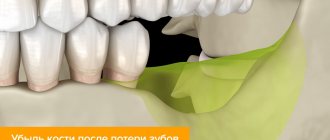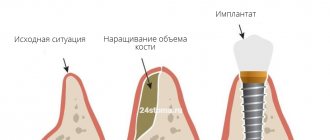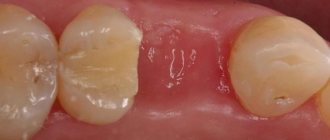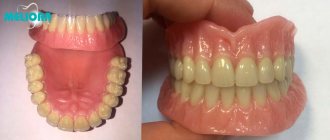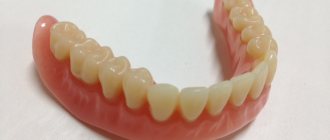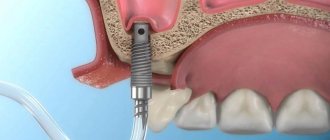Implantation is a method of restoring lost teeth by installing titanium analogues of tooth roots for subsequent prosthetics. The implant is fixed into the jawbone, which ensures its immobility and stability. If a tooth is missing for a long time, the bone atrophies, so before implantation it is built up. Neglecting osteoplasty is dangerous for the development of serious complications.
What are the complications of installing implants in case of bone atrophy?
In conditions of insufficient bone tissue, the implant will not be able to be firmly fixed, which can lead to its loss. Additional risks arise on the upper and lower dentition, which differ due to the structure of the jaws and the quality of the bone tissue.
On the upper jaw
Due to the lower chewing load, the bone tissue of the upper jaw is more loose compared to the lower jaw. Therefore, when teeth are lost, atrophic processes occur faster. If implantation is not carried out on time, after six months the bone loss will be more than 60%, in the area of the maxillary sinuses - about 80%. Installing an implant in such a situation is risky. If the rods are longer than the remaining bone, there is a high risk of damage to the bottom of the nasal sinuses, which is dangerous due to infection and the development of sinusitis.
On the lower jaw
The bone tissue of the lower jaw is more dense in structure. When teeth are lost, it is absorbed less intensively. However, a long-term lack of solution to the problem subsequently makes implantation difficult. This is due to the close location of the trigeminal nerve, which is responsible for the functionality of the lower part of the face. When the gums sag, the distance to it becomes minimal. Installation of implants is fraught with nerve damage, loss of sensitivity of the lips, cheeks and tongue.
Related articles:
- Implantation of upper teeth
- Implantation of lower teeth
- Treatment guarantees
Complications after the intervention
After the installation of foreign materials, as with any surgical procedure, complications may occur. However, if the procedure is followed and bone grafts are selected correctly, the risk of their occurrence is minimal. In general, the patient may experience the following complications:
- inflammation of tissues in the area;
- displacement or separation of the bone block due to load;
- exposure of the membrane in the gum area;
- suture dehiscence, tissue suppuration, which “spreads” to neighboring areas.
After installing the grafts into their own tissues, the patient needs to undergo a rehabilitation period so that the pain decreases and the implants take root in the future. In the first days after bone grafting, there may be bleeding, tissue swelling (ice compresses usually help), pain in the throat, neck, and jaw areas.
To eliminate the risks of bone grafting and successfully install long-lasting implants at an affordable price, contact the Moscow Mazot clinic. Experienced surgeons will carry out extensions, select an intervention scheme and material that will be accepted by your own tissues. To know how much medical help costs and how you can solve the problem of lost teeth, sign up for a consultation at Mazot.
Why and how osteoplasty is performed
Bone grafting is necessary when the available volume of bone tissue is not enough to create reliable support for a dental implant. It is carried out in the following ways:
- Sinus lift. Indicated only for the upper jaw in the area of the chewing teeth, above which are the maxillary sinuses. Access to the bottom of the sinus is created in the bone, the sinus membrane is lifted with special instruments, and the resulting space is filled with osteomaterial. The operation is performed using an open or closed method. The first is more traumatic and is used when it is necessary to significantly increase the size of the bone. Simultaneous installation of implants is possible if the thickness of the remaining bone is at least 4 mm. Otherwise, sinus lifting is carried out in a separate preliminary stage. The recovery period takes 5-6 months.
- Bone grafting (BMG). Relevant for small defects. The graft used is xenogeneic material based on bovine bone or synthetic materials that stimulate growth. To give the desired shape and protection from external factors, the area to be grown is covered with a barrier membrane. The procedure is low-traumatic, but financially expensive.
- Bone block transplantation. It involves transplanting the patient’s own jaw block, taken from other parts, into the problem area. The bone block is fixed with ultra-thin screws and covered with a collagen membrane. It takes 6-8 months to survive. In our Center, the method is not used because it is traumatic and requires additional surgical intervention to collect material.
- Splitting of the alveolar ridge. Allows you to increase the jaw bone only in thickness. A cut is made in the middle of the bone, which is expanded with special tools. Then the implant is fixed into the resulting gap, and the space around is filled with osteomaterial. Rehabilitation after surgery takes up to 4 months. We do not use this technique due to increased trauma and the risk of non-healing of the titanium structure.
Bone grafting with further tooth implantation
Get a consultation
We will answer all your questions before visiting the clinic!
+7
Online registration
Use of barrier membranes
With the help of such structures, it is possible to secure the bone contents and increase its size. They serve to separate the bone and mucosa, and are installed during osteoplasty. In this case, there is no risk of mucous membrane growing into the bone.
Various types of materials are used as part of the procedure. In addition to your own bone material, the use of synthetic contents, donor raw materials and material removed from the animal’s body is allowed.
Currently, in order to accelerate the formation of the jawbone, biocompatible membranes are installed. This process is called guided bone regeneration. Since the membranes used consist of a special collagen material, they are well accepted by the human body.
If there is a need to ensure maximum protection and safety, prevent infection, eliminate increased stress and achieve stability of the implanted material, non-absorbable devices with a metal base are used.
The wound is sutured immediately after fixation of such structures. In this case, before installing dental systems, it is necessary to wait a period of 12 to 24 weeks. In some situations, with minor atrophy, implantation systems can be fixed at the same time as bone grafting.
Stages of implant installation for bone deficiency
Implantation in case of bone deficiency is necessarily preceded by bone grafting. It can be carried out as a separate stage or simultaneously with the installation of titanium roots. It is strictly forbidden to install a crown or prosthesis immediately after the procedure. It is important to ensure reliable fusion of the graft and artificial root with the jaw bone to avoid displacement. Implantation includes the following stages:
Preparatory
The most important stage to which we pay maximum attention. We examine the patient’s oral cavity, identify diseases of the teeth and gums, and prescribe treatment. We examine the maxillofacial apparatus, determine the size of the bone, on the basis of which a decision is made on the need for osteoplasty. Also at the preparation stage, a diagnosis of the patient’s health condition is carried out to identify possible contraindications. At the same time, surgery planning, computer modeling, selection of models and placement of implants in the jaw are carried out.
Bone tissue augmentation
If atrophy of the jaw bone is detected at the preparatory stage, osteoplasty is performed. Rehabilitation after the procedure takes 4-5 months. During this time, the transplant completely takes root. If the bone size allows, bone augmentation is carried out simultaneously with implantation, which significantly reduces treatment time.
Implantation
Performed using a patchwork method. The implantologist dissects and peels off the gum mucosa, uses special tools to form a hole into which he screws the implant and performs manipulations to increase the size of the bone (if one-step plastic surgery is indicated). Then he closes the rod with a plug screw and applies sutures. Osseointegration of the artificial root with the jaw tissue takes 4-5 months. During this time, a temporary removable denture is made to hide the aesthetic defect.
Prosthetics
After the structure has healed, the gum is dissected again, the plug is removed, and a gum former is placed to create a beautiful gum contour. After 2 weeks, the former is replaced by an abutment, and impressions are taken. The final stage is fixation of the crown or fixed prosthesis.
Contraindications
You cannot perform surgery on the jaw tissue if:
- immunological pathologies;
- low blood clotting;
- malignant tumor neoplasms;
- severe diseases of the cardiovascular system.
The intervention will not be possible if the patient is allergic to dental anesthetics. The procedure is quite painful and cannot be performed without anesthesia.
Price
Our Center operates a case payment system for treatment. This pricing policy eliminates unexpected costs for patients that they often encounter in other clinics. The turnkey price includes a set of procedures and materials for a specific service.
The implant installation case includes:
- anesthesia;
- implant Nobel Biocare (Switzerland), installation;
- consumables and superstructures;
- anesthesia;
- CT scan of the jaw before and after implantation.
Case on sinus lift and NBR:
- anesthesia;
- consumables (except bone);
- operation;
- applying and removing sutures;
- a set of medications to take home;
- examinations and control CT image.
You can view the prices for services in our Center here.
Is implantation possible without osteoplasty?
In some cases, implantation without osteoplasty is possible, but more often it is a temporary solution or an operation without a guarantee.
Installation of mini implants
Implantation using mini-implants is usually performed with complete edentia. In this case, there are no requirements for the height and density of the jawbone. Implants of reduced size are fixed in the gums in a minimally invasive way without involving bone structures. Serve as additional support for conventional removable dentures. However, this is a temporary solution; such structures are short-lived.
Application of one-stage implantation protocols
Some clinics practice installing implants using immediate loading protocols - All-on-4, All-on-6, basal complex. The first two are used in cases of complete absence of teeth, basal - from 3 teeth in a row.
To install artificial roots, areas of the jaw are selected where at least a minimum volume of bone is still preserved. Since thin implants are used, they are fixed at an angle in the area of the chewing teeth to create a large area of contact between the artificial root and the thinned bone. With basal implantation, the deep layers of the jaw are involved, which are not subject to atrophy. The prosthesis is fixed immediately.
We do not recommend such experiments, since they contradict the entire law of biomechanics. Any orthopedic structures must be supported by implants installed in parallel. In this case, there will be no overload in the area of connection between the prosthesis and implants. In addition, basal implants fail in 40% of cases. It is better to grow the bone, wait for engraftment and carry out implantation without risks.
Other methods
In some cases, osteoplasty is avoided due to tricks, which we also do not recommend:
- When installing shortened implants to restore anterior teeth. This is due to the fact that in the frontal region of the jaw there is a slight decrease in bone height. But this approach does not guarantee success, since artificial roots of small diameter, but always of the required length, must be installed for the front teeth.
- When installing rods in the area of the posterior wall of the nasal sinus. The location outside the sinus allows the use of traditional implant models due to the greater height of the bone in this section. But when calculating the placement of implants, the law of distribution of chewing load must be taken into account and the correct distance between several roots must be observed.
- When using the thinnest and shortest rods from a number of classic ones on the bottom row, bypassing the trigeminal nerve. This option will not ensure the fulfillment of the functional responsibilities of the roots. With chewing loads, they can become loose or even break.
Alternative Methods
Removable dentures Recommended if there are absolute contraindications to implantation or if there is a limited budget
ReSmile Modern technology for rapid restoration of teeth with complete edentia with the installation of a permanent prosthesis
Mini-implants Removable prosthetics with mini-implants MDI
Article Expert
Nesterenko Alexey Pavlovich Surgeon-implantologist, doctor of the highest category
Work experience: more than 10 years
In our Center we use only proven techniques
As an alternative to osteoplasty to eliminate the risk to the patient's health, we use bone morphogenic protein . After administering the drug to the area of bone tissue deficiency, the process of stimulating regenerative mechanisms begins. The body produces the tissue itself, and bone cells are attracted to the injection area.
Levin Dmitry Valerievich
Chief physician, Ph.D.
What can replace implantation?
Implantation is the only method of restoring lost teeth that stops bone resorption. But there are cases when surgery is contraindicated or a person is not financially ready to undergo surgery. As an alternative from an aesthetic and functional point of view, the following are used:
- Removable dentures. They consist of a plastic base that serves as the gum and artificial teeth attached to it. Made from acrylic or nylon. Service life - 5-10 years. Due to improper load distribution, they put increased pressure on the gums, sag, and require constant relining. The jawbone under such prostheses is actively decreasing.
- Bridges. Several crowns welded together, the outermost of which are attached to the previously ground living teeth adjacent to the defect. Made from metal ceramics or zirconium dioxide. The average service life is 7 years (depending on the condition of the supporting units). Due to uneven pressure, the bone in the defect area is resorbed.
We recommend not to delay the restoration of the dentition and consider implantation as an effective way to stop the process of bone tissue atrophy. Complete resorption over time makes any type of prosthetics almost impossible.
Kinds
Osteoplasty is classified based on the material that is used to restore the volume of a “sagging” jaw. It happens:
- Autogenous. This means that the patient’s bone is used during treatment. The option is considered the most effective, since the risk of rejection is minimal. However, it is more complex and traumatic than the others - after all, you need to get a sample from somewhere, and this is another operation.
- Allogeneic. The client is provided with material that was taken from a person who bequeathed his organs to achieve various medical purposes. The workpiece is selected very carefully, sterilized, and processed using special technology. Over time, it successfully takes root, thanks to which the dentition can already be used for implantation.
- Xenogenic. The difference from the previous solution is that tissue is taken not from a deceased person, but from an animal (most often from cattle). Cow bones are processed, sterilized, and prepared using innovative technology. As a result, they become compatible with the tissues of the human body. Experience shows that such structures take root well.
- Alloplastic. Involves the use of a synthetic sample. Alloplasty is a new word in the field of implantology. The doctor fixes materials into the jaw, which over time turn into a frame or completely dissolve. After their installation, active independent bone regeneration occurs.
Why does bone loss occur?
When teeth are lost due to lack of natural load, the jaw bone atrophies. The process is activated 3 months after removal and reaches its climax within a year. Among the secondary reasons for the reduction of bone tissue in size:
- chronic inflammatory diseases of the oral cavity;
- age-related weakening of the tissues surrounding the tooth in older people;
- congenital pathologies of the dentofacial apparatus;
- jaw injuries;
- dentures supported by living teeth or gums.
Bone resorption leads to the following consequences:
- psychological discomfort due to a gap in the dentition, difficulty eating;
- change in the shape of the face: the appearance of wrinkles in the mouth, sagging cheeks, displacement of the chin, sunken lips;
- the need to reline a removable denture when using it.
Operation
To replenish bone deficiency, the doctor:
- Administers a local anesthetic. It makes only the treatment area insensitive. The patient is conscious, can respond to the doctor’s words, and communicate with gestures. There is no need to use general anesthesia for such manipulations.
- Gently dissects soft tissue and periosteum. As a result, he gains access to the bone.
- A previously prepared graft is inserted into the resulting cavity and fixed there with miniature screws.
- Covers the cut area with a special protective membrane. It does not allow pathogens, bacteria, or food debris to penetrate the wound, that is, it creates ideal conditions for the smooth occurrence of regenerative processes.
- Places stitches.
It is very important to follow all doctor’s instructions after treatment. Only then will it be possible to avoid complications such as rejection of donor material, suppuration, inflammation, etc.




